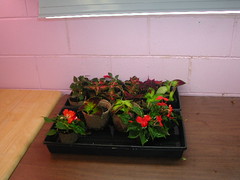It's been a busy week with Labor Day gatherings and the start of school. Start of school??? I retired.... but I spent 2 days celebrating that fact with my girlfriends. Best start of school we ever had!!
The weather has turned suddenly cool and damp. Actually all my plants needed the break, especially they need the moisture. Suddenly I'm seeing signs of Fall. A scattering of leaves are showing up on the lawn; the hostas are tinged with brown; basil, mint, and coleus insist on going to seed no matter how many times I trim their tops. Soon, very soon, I've got to get into those perennials and thin them out. We've had 80's temps right up to this week, but frost is surely on its way.
The asters I grew in pots from seed are finally in bloom. I have watered and waited patiently for them all summer. The wait was worth it because just as other flowers are winding down, these gems have exploded in shades of pinks and purples. They are similar in shape to mums, but I've never seen mums in these colors. The asters make great cut flowers, and have worked well in flower arrangements.

I used the asters to make a floral arrangement for one of my girlfriends. This is not hard to do at all with some floral sponge. Choose a container that can hold water and cut the sponge to fit. Soak the sponge in water until thoroughly wet, and put it in your container.
Now comes the fun part. You want to collect a variety of flowers and greenery from your garden. For greens I like to use sprigs of boxwood, ferns, varigated spirea. For flowers, use any flower that can be considered a "cut flower". Asters, black-eyed susans, mums, roses, zinnias, lilies are just a few that work for me. Lastly, I like to add something that is a little bit of a surprise such as seed pods or colored leaves. Coleus, silver dollar seed pods, coral bell blossoms fall into this category for me. Strip the lower leaves before you gently push the stems into the floral sponge. I like to start in the middle (usually the highest point of the arrangement) and work in a circle to the edges. This helps make it pleasing to look at from all sides. Try to make sure all the floral sponge gets covered. There really is no wrong way to do this. Try out different arrangements until you get something that is pleasing to you. This is a fun, easy project, and your friends will be impressed.





























